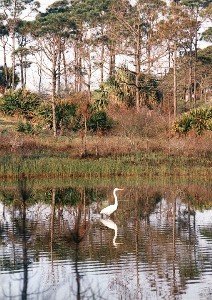
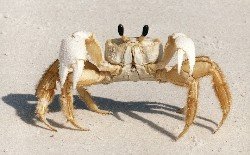
This beach is certainly not the most popular in terms of number of visitors, but that is exactly why it is so wonderful. St. Joseph Peninsula is a long, narrow spit of land curving north from Cape San Blas, located on the Gulf of Mexico between Pensacola and Tallahassee, Florida. It is quite a distance from the main highway and visitors get the impression they are far from civilization. St. Joseph Peninsula State Park covers the entire strip of sand dunes, pines, and ponds, from an area so narrow that, from the low dunes, you can see at the same time both the Gulf and Eagle Harbor in the Bay, and all the way to the sandy tip of St. Joseph Point. When staying at either of the two campgrounds, it is possible to begin a walk from your site, travel along the Gulf beach, around the point, and back on the beach bordering St. Joseph Bay, arriving right back at your campsite. The trip is probably about fifteen miles and takes all day. Like most beaches in Florida, this one does not allow vehicles (except for the rangers' little dune buggy). The only way to access the beach is by foot or boat. The paved road ends near the campgrounds and there is only a sand lane for emergency access beyond that.

The campgrounds, like all those in Florida state parks that I've visited, are very pleasant. They are well maintained, have plenty of shade and privacy, and don't allow dogs; it is quiet as well as clean, and native fauna abounds. The raccoons and skunks can get to be pesky, mostly because people feed them, but are also entertaining.
I've taken the beach walk around the peninsula so many times over the years that I've lost track. I've seen the water when it is crystal clear and sapphire blue in the heat of summer, and also seen it the color of gray marble during the middle of winter. It is easy to complete the trek well within daylight hours from spring through fall, but getting through the entire trip without having to stumble back in the dark is tough during the brief days around the winter solstice. You would think that a fifteen mile trip shouldn't take more than eight or nine hours, even allowing for rest stops. However, this beach is always so interesting that one is lured to dawdle and play, watching the waves and wildlife, forgetting that the journey back is just as long as the one out.
At first, I made the trip with my mother, Evelyn, and sister, Vicky. Later, I would do it alone or take a friend from college. For the most part, it was a solitary trip, since in all those miles of beach, it was rare to encounter another person. Sometimes I'd meet people who had just pulled their boat up for a break, but most of the time I'd only see ships and boats at a distance, or sometimes a park ranger riding by on his little beach vehicle, checking for stranded hikers. The last time I went, with my mother, was several years ago.
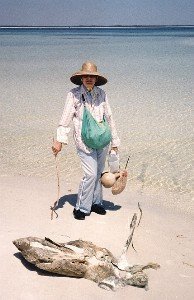
For some reason, we always start on the gulf side, finishing on the bay. It works out nicely, except for the small detail of having to find our way back to the campground through the forested beach. For many years, there was one path that led right back to the paved road, making the final leg of the journey quite easy. The trouble was finding this path. Cut in too early and we had to slog through the soft sand, not the sort of physical effort one wanted after walking all day. Go too far and the beach disappeared, gradually becoming a grassy, boggy swamp, not much fun to wade through. The first couple times we found the path by sheer luck. Then, for about a decade, there was a pillow washed up and lodged in the roots of the palm trees just before the trail. As time went on, the pillow got more and more ragged, but was always in the same place, a welcome sign after the long hike. Now, there are cabins along that final stretch, with board walks that go right to the water. Nobody can miss them.
One thing that was always a mystery until we actually got to the large, flat sand area of the point, was what the topography would be that time. The point is subject to strong currents and the battering of the waves, changing shape regularly. There is a large salt lake near where the channel to the mainland began. Sometimes this inlet was completely cut off from the sea and we could just walk on the beach all the way. At other times, there was a channel connecting it to the main waterway. This could be small enough to wade or very wide and deep. Since we didn't like all the sharks in the area, we never went across if the water was deeper than about four feet, instead backtracking around the other side of the lagoon. Of course, the tidal level also made a difference.
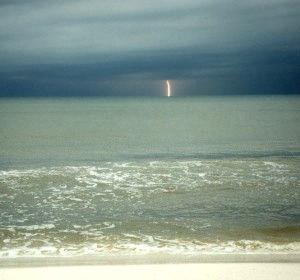
The point curves so much that it is like climbing to the top of a mountain, where you keep thinking that you have reached the summit, only to see you have farther to go each time you attain the next ridge. The curve seems to go on and on, with large sand flats covering the entire area. The actual point, where the currents meet, is not terribly dramatic. It is fun to walk quite some distance out into the shallow water covering the sand bar and feel the waves lap at your legs from both sides. There are often big flocks of sea birds taking advantage of the changing currents and tides.
Aside from some low dunes, picturesque palms and pine trees, and white sand, the beauty of this area is not the sort that would blow you away, like seeing the huge waves of Hawaii, or the towering cliffs of Washington and Oregon. Instead, the scenery is subtle, changing its mood and character depending on the season and weather. Because there is little shade until reaching the palm trees on the Bay side, protection from the sun is essential. Winter, when I've had to wear a coat anyway, presents no problem, but in summer we take many cooling dips in the water during the trip.
Such a desolate beach, located at a convergence of currents, of course makes for GREAT beachcombing. Depending on what the shrimp boats, the paper mills on the far side of St. Joseph Bay, or the storms have dumped, you never know what you'll find. I've seen things as small as tiny horseshoe crab shells, each only ½ inch long washed up by the thousands. One time we found an almost buried skull of a whale (third photo). Other notable discoveries included the largest alligator skull I've ever found, the largest loggerhead turtle skull, and the largest whelk shell. I've chanced upon all sorts of shells and bones, often lugging back several pounds of interesting stuff to enjoy at the campground. Once, while walking alone, I met a couple who had just beached their boat so the woman could do some shell collecting. Unfortunately, the area they chose didn't have any seashells this time; but I had picked up some nice specimens several miles back and gave her most of them, an ideal exchange since she was thrilled to get them and I still had a ways to go, with the load getting heavy.
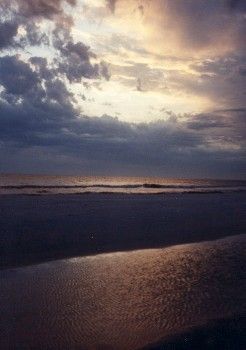
The wildlife in the park is about as accessible as it can get. In and around the campgrounds, there are always the usual small varmints, along with deer and large wading birds feeding at the ponds and lagoons. At low tide there is nothing more enjoyable than walking in the shallow water all over Eagle Harbor, looking at the myriad creatures living in the sea grass. This was the first place I ever saw the blue eyes of a scallop, and we often found small fish, snails, crabs, and sea urchins there. Along the beach walk, sightings of pelicans feeding, schools of rays, and dolphins are common. The swallow-tailed kite, with its graceful long tail flowing in the breeze, can often be seen flying over the pines, and ospreys hunt over the water.
The last time my mother and I hiked the point, late in May, all started well and we had plenty of food, water, and sun protection. As we were hiking to the tip, the sky changed dramatically and a huge front moved in from the west. We could see dark clouds, lightning, and the water starting to churn in the wind. By the time we reached the point, it was raining steadily and the temperature had dropped into the 50°s. Unfortunately, it was not a brief passing storm. The rain continued the entire time we were walking back, so we were drenched for hours. We stopped a couple times to hunker down under the shelter of wrecked boats, or to create make-shift ponchos from tarps we found. However, the last couple miles were especially hard for me, as I had hypothermia so badly that it hurt to walk. My mother, despite her age, managed just fine. We reached the campground with a couple hours of daylight to spare. The rain stopped and, after a hot shower and a dry change of clothes, I felt good as new. We enjoyed a dramatic sunset on the beach that evening.